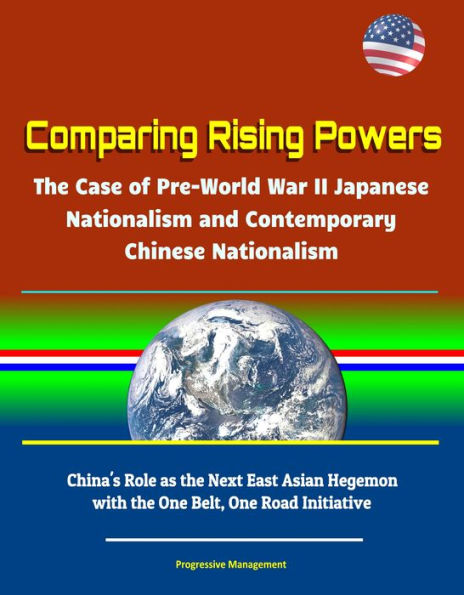This excellent 2018 report has been professionally converted for accurate flowing-text e-book format reproduction.
Pre-World War II Japan, throughout the first half of the twentieth century, was a nation with a strong military force, growing economy, and unique ethnic identity. Contemporary China exhibits similar characteristics in the first part of the twenty-first century. Culture, language, geography, military force, economy, and religion, to name only a few, are frequently referred to by scholars as sources for uniting people under the banner of nationalism. Oftentimes, a mix of these aspects helps to establish national unity and identity. Were Japan's military, economy, and culture the main drivers of Japanese nationalism before 1945, and are these same factors driving Chinese nationalism today? After comparing similarities between Japanese and Chinese nationalism and the roles the military, economy, and culture play as primary drivers for building national unity, this study finds that Japan's military in the early twentieth century primarily drove national unity, with ethnic racism and economy as close supplementary factors. China's economy, on the other hand, has been the primary factor for building national unity today. Japan's interaction with the League of Nations and China's One Belt, One Road initiative and interaction with regional institutions greatly influenced each state's primary driving factor. Where Japan's approach to nationalism failed in interaction with international institutions, China has succeeded, and a united China may very well be the next East Asian hegemon. Will Chinese nationalism result in war?
I. INTRODUCTION * A. MAJOR RESEARCH QUESTION * B. SIGNIFICANCE OF THE RESEARCH QUESTION * C. LITERATURE REVIEW * 1. Nationalism * 2. Japanese Nationalism * 3. Chinese Nationalism * D. POTENTIAL EXPLANATIONS AND HYPOTHESES * E. RESEARCH DESIGN * F. THESIS OVERVIEW AND CHAPTER OUTLINE * II. JAPANESE AND CHINESE APPROACHES TO INTERNATIONAL INSTITUTIONS * A. JAPAN'S RISE IN THE NINETEENTH CENTURY * 1. Japan's Relationship with the League of Nations * 2. Japan and the Washington Conference * B. CHINA'S APPROACH TO INTERNATIONAL INSTITUTIONS * 1. International Institutions Emphasizing Economic Cooperation * 2. International Institutions Emphasizing Security Cooperation * 3. One Belt, One Road Initiative * 4. Financial Institutions Supporting OBOR * C. CONCLUSION * III. JAPANESE AND CHINESE APPROACHES TO NATION-BUILDING * A. JAPAN AMONG MODERN NATIONS * 1. Centrality of Ethnicity to National Understanding * 2. Korea's Perception of Japan * 3. Western Perception of the Japanese * B. CHINA'S RISE IN THE TWENTY-FIRST CENTURY * 1. China's One Belt, One Road Plan * 2. Response of International Actors to OBOR * C. CONCLUSION * IV. SUMMARY, CONCLUSIONS, AND RECOMMENDATIONS
This excellent 2018 report has been professionally converted for accurate flowing-text e-book format reproduction.
Pre-World War II Japan, throughout the first half of the twentieth century, was a nation with a strong military force, growing economy, and unique ethnic identity. Contemporary China exhibits similar characteristics in the first part of the twenty-first century. Culture, language, geography, military force, economy, and religion, to name only a few, are frequently referred to by scholars as sources for uniting people under the banner of nationalism. Oftentimes, a mix of these aspects helps to establish national unity and identity. Were Japan's military, economy, and culture the main drivers of Japanese nationalism before 1945, and are these same factors driving Chinese nationalism today? After comparing similarities between Japanese and Chinese nationalism and the roles the military, economy, and culture play as primary drivers for building national unity, this study finds that Japan's military in the early twentieth century primarily drove national unity, with ethnic racism and economy as close supplementary factors. China's economy, on the other hand, has been the primary factor for building national unity today. Japan's interaction with the League of Nations and China's One Belt, One Road initiative and interaction with regional institutions greatly influenced each state's primary driving factor. Where Japan's approach to nationalism failed in interaction with international institutions, China has succeeded, and a united China may very well be the next East Asian hegemon. Will Chinese nationalism result in war?
I. INTRODUCTION * A. MAJOR RESEARCH QUESTION * B. SIGNIFICANCE OF THE RESEARCH QUESTION * C. LITERATURE REVIEW * 1. Nationalism * 2. Japanese Nationalism * 3. Chinese Nationalism * D. POTENTIAL EXPLANATIONS AND HYPOTHESES * E. RESEARCH DESIGN * F. THESIS OVERVIEW AND CHAPTER OUTLINE * II. JAPANESE AND CHINESE APPROACHES TO INTERNATIONAL INSTITUTIONS * A. JAPAN'S RISE IN THE NINETEENTH CENTURY * 1. Japan's Relationship with the League of Nations * 2. Japan and the Washington Conference * B. CHINA'S APPROACH TO INTERNATIONAL INSTITUTIONS * 1. International Institutions Emphasizing Economic Cooperation * 2. International Institutions Emphasizing Security Cooperation * 3. One Belt, One Road Initiative * 4. Financial Institutions Supporting OBOR * C. CONCLUSION * III. JAPANESE AND CHINESE APPROACHES TO NATION-BUILDING * A. JAPAN AMONG MODERN NATIONS * 1. Centrality of Ethnicity to National Understanding * 2. Korea's Perception of Japan * 3. Western Perception of the Japanese * B. CHINA'S RISE IN THE TWENTY-FIRST CENTURY * 1. China's One Belt, One Road Plan * 2. Response of International Actors to OBOR * C. CONCLUSION * IV. SUMMARY, CONCLUSIONS, AND RECOMMENDATIONS

Comparing Rising Powers: The Case of Pre-World War II Japanese Nationalism and Contemporary Chinese Nationalism - China's Role as the Next East Asian Hegemon with the One Belt, One Road Initiative

Comparing Rising Powers: The Case of Pre-World War II Japanese Nationalism and Contemporary Chinese Nationalism - China's Role as the Next East Asian Hegemon with the One Belt, One Road Initiative

Product Details
| BN ID: | 2940155290797 |
|---|---|
| Publisher: | Progressive Management |
| Publication date: | 06/09/2018 |
| Sold by: | Smashwords |
| Format: | eBook |
| File size: | 345 KB |
